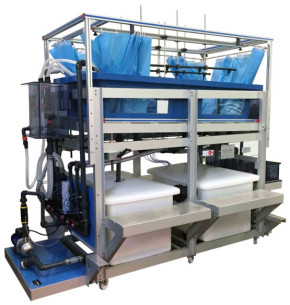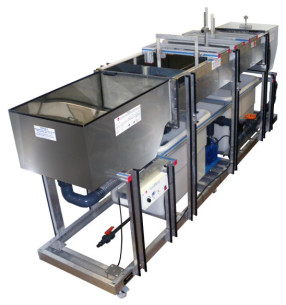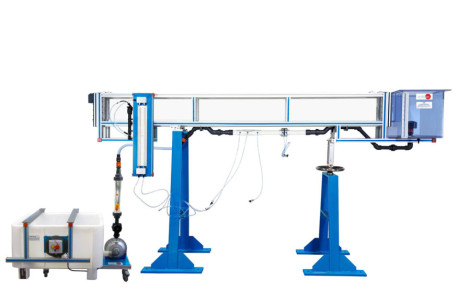The Hydrological Systems, Rainfall Simulator and Irrigation Systems (2x1 m), "ESH(2x1m)", has been designed by EDIBON to demonstrate some of the physical processes encountered in hydrology and fluvial geomorphology. This includes rainfall hydrographs for areas with variable permeability catchments, the formation and characteristics of rivers, the effects of sediment transport, and the extraction of groundwater through drainage, with or without surface recharge from rainfall, etc.
This unit allows demonstrating, on a small scale, the hydrological principles of ground water flow and the applications of these principles to some engineering constructions. Moreover, it allows to study the use of drains for water abstraction, de-watering and drainage of lakes, and demonstration of flood risks linked to land drainage works.
The main element of the unit is a test tank, which can be filled with sand and its tilt regulated by a lifting system. Water is supplied to the test tank through different systems: from two flexible separate hoses (simulating water inlets), from an inlet tank (simulating a river), from spray and showers nozzles located above the tank (simulating rain), or from french drains. Water is output from a river outlet tank, from the drainages located on two test tank corners, from the french drains, which have independent outlets, or from the overflows.
Two large plastic storage tanks are located under the test tank to store water.
A pump, with speed regulation, impels water from the storage tanks to the test tank.
Two flexible separate hoses, placed at the test tank front side, allow adding great inlet flows.
In order to be able to simulate a river, the test tank has a tank attached to the inlet and other tank attached to the outlet. Gravel can be put inside the river inlet tank to deaden the flow and avoid turbulence. The use of a suitable channel section provides appropriate flow conditions in the test tank. The river outlet tank is located at the other end of the test tank and is used for hydrographs, run-off and river formation demonstrations.
The river tanks are communicated with the test tank through a floodgate that has two trap doors, a hermetic one and a meshed one.
Eight spray nozzles are mounted at a double line mobile bridge placed on the test tank and are arranged in a longitudinally equidistant way to provide an even water distribution along the test tank. These nozzles are also adjustable in height and width and can be easily fixed. Each nozzle has an associated ball valve, allowing a wide variety of moving rain precipitation patterns to be simulated.
Two shower nozzles with multiple flows are placed on the test tank and allow storms and local inputs simulation. These nozzles are also adjustable in height and length, and they can be separated from the support to move them manually.
The subsurface flow inputs are via two french drains, located in the middle of the test tank. These french drains extend the full width of the tank. Each french drain can be configured as an inlet or an outlet to permit a wide variety of hydrological demonstrations.
The outlet tank consists of a sediment collection basket.
There are three tanks at the rear part of the unit, each of them connected to one french drain and the other one connected to the drainages. Each one of these tanks has a spillway, which allows to calculate the outlet flow of each tank. The water flow in each tank is measured by a depth gauge. The outlet system (from french drains or drainages to tanks) includes three diaphragm valves to regulate the flow.
The test tank includes two overflows that are communicated with the storage tanks. The water table can be kept constant by means of these overflows, with adjustable height.
The flow of all the inlet systems can be regulated by a group of diaphragm valves located at the front side of the unit. There are six orifice plates that allow measuring and control the water flow in each pipe of the inlet system with a panel of manometric tubes. A flow meter is located at the outlet of the pump. Filters are included in the water supply lines, minimizing system disturbances.
The test tank includes 23 tapping points configured in a cruciform pattern. These 23 tapping points have two functions, depending on the position of the valves included. On the one hand, they are used to taking samples to chemically analyze the water at the twenty three points, a feature that allows to broaden the use of the unit to the study of drag and transport of fluvial polluting agents. On the other hand they are used to measuring and display the phreatic surface (or ground water table levels) in several panels of manometric tubes.
 Cookies首选项
Cookies首选项





















